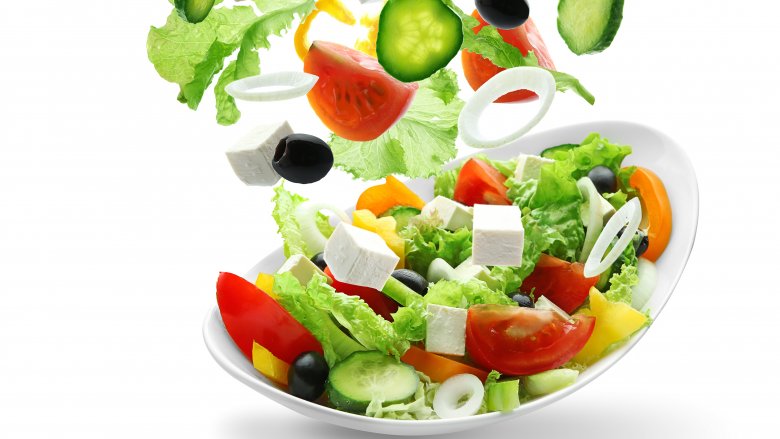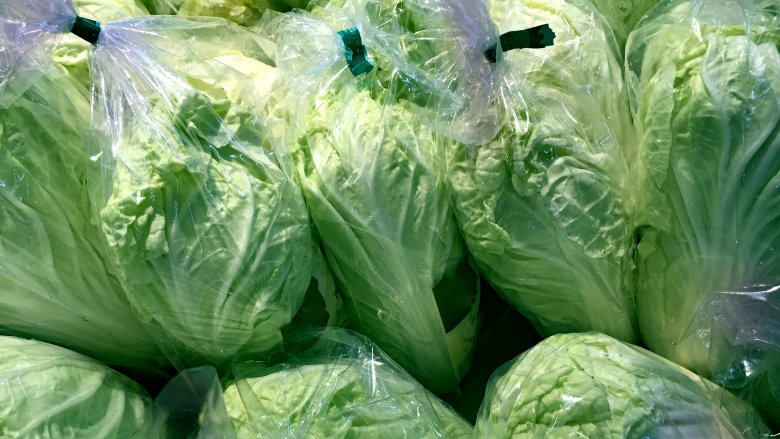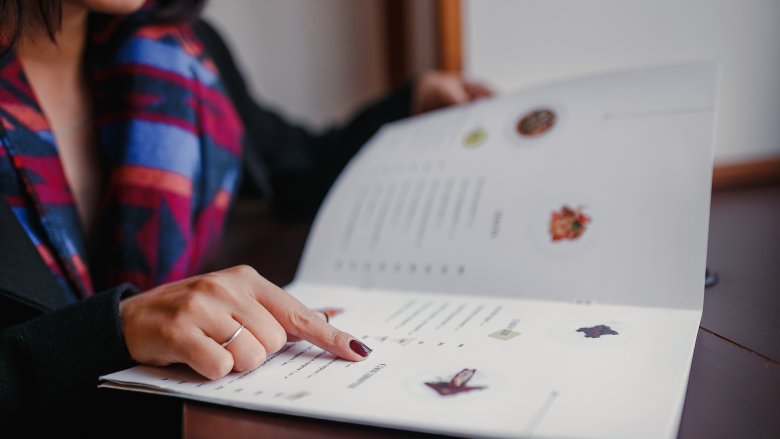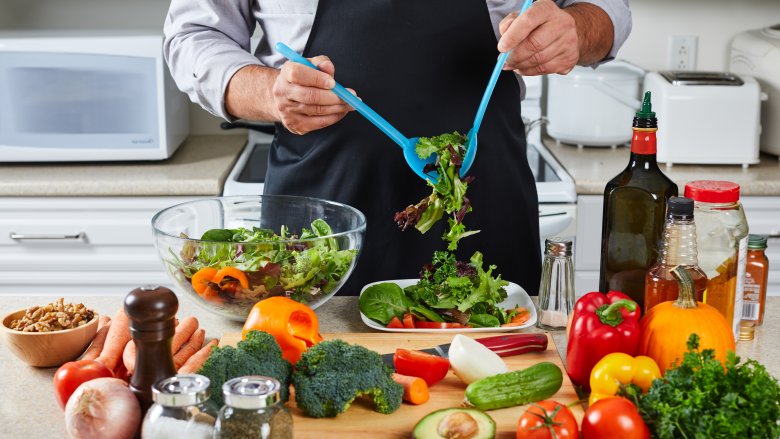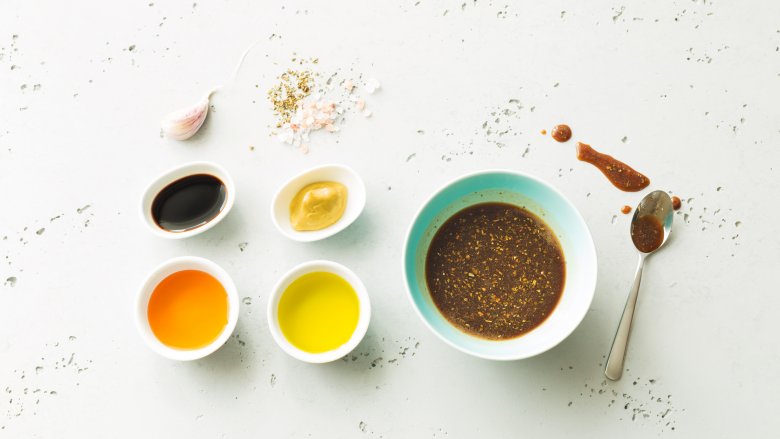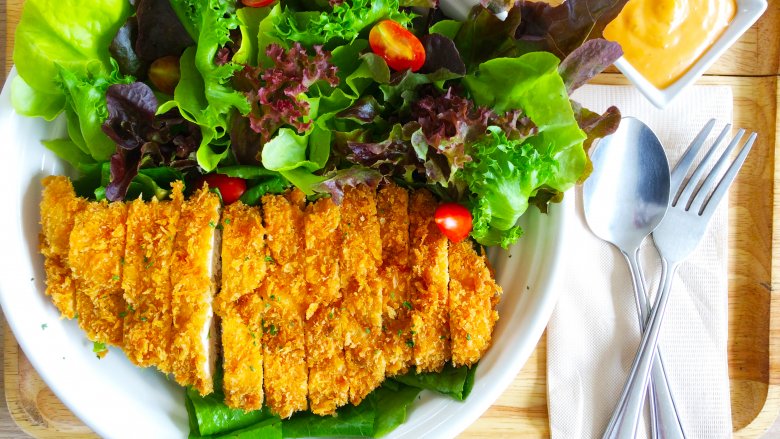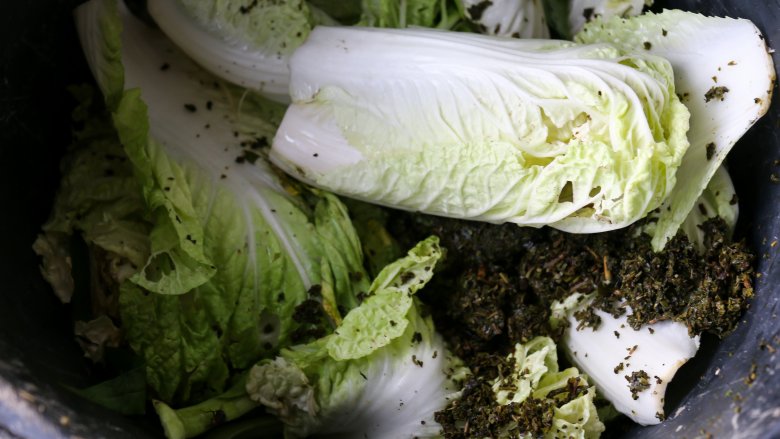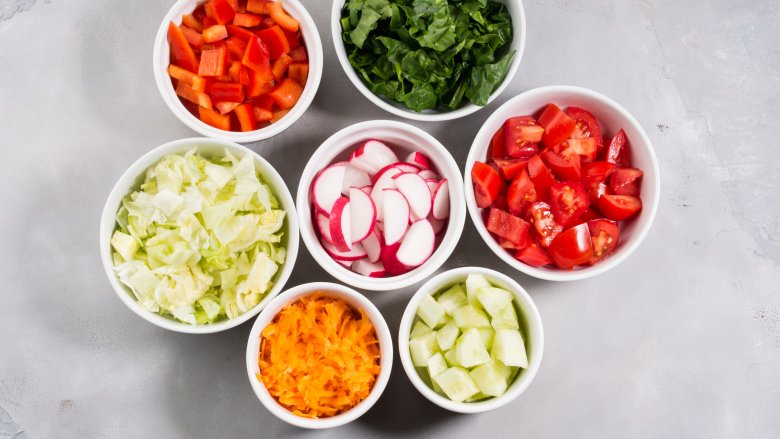The Real Reason You Should Never Eat Salad At Restaurants
Have you ever walked into a restaurant, glanced at the menu, declared, "I'll have the salad," and felt really good about yourself?
Then you, my friend, may have fallen victim to the "health halo" effect, a phenomenon where diners overestimate the virtuousness of a "healthy" food. The aforementioned health halo hovers above sneakily insalubrious items like trail mix, fruit juice, and agave nectar. But when it comes to foods basked in the glow of a misleadingly bright health halo, the innocent restaurant salad may be gleaming the brightest.
Too often, salads are assumed to be the healthiest options when dining out. But hidden beneath the layers of iceberg, spinach, and arugula, your restaurant salad may be hiding dirty, less-than-healthy secrets.
The next time you're at a restaurant, don't immediately presume that the house, Cesar, Cobb, or any other type of leaf-and-raw-veggie based dish is your healthiest option. Before placing an order, check out these reasons you should never eat salad at restaurants.
Salads come with a high risk of contamination
Compared to cooked veggies and meats, salads carry the highest risk of contamination. Leafy greens, in fact, are behind a fifth of all foodborne illnesses. Food poisoning expert Bill Marler told Business Insider that he would sooner eat sushi than restaurant salad, pointing out the link between raw vegetables like sprouts and lettuce to outbreaks of E.coli and salmonella.
The risk is higher if restaurants use pre-washed, pre-chopped salad mixes, which can stimulate the growth of dangerous bacteria. Bagged salad greens are vulnerable to cross-contamination because they are subject to additional processing from humans and machines. Over recent years, bagged salads have made headlines for being behind outbreaks of listeria, salmonella, E.coli, and cyclospora parasites.
If a restaurant salad is labelled "organic," don't be fooled into thinking it's safer. Experts have suggested that organic produce can pose an even greater risk of contamination from bacteria like E.coli, shigella, and salmonella depending on how they are harvested and handled. In addition, research has found organic produce may be more vulnerable to mycotoxins because they are farmed and stored without the use of conventional fungicides. Mycotoxins, toxic compounds produced by fungus, may lead to live cancer if consumed over time.
Salads tend to be the biggest rip-off on the menu
Depending on the ingredients, your restaurant salad could be the biggest flimflam on the menu. Although many salads come with a lower price point other menu items, they also generally carry huge markups. Fancy restaurants can charge anywhere from $8 to $14 for a salad made from giant, wholesale bags of lettuce they purchased for a couple of bucks. Even restaurants that rely on fresh, locally sourced ingredients could be making a massive profit, particularly during the spring and summer when produce is abundant and cheap.
Take the iceberg wedge salad, for instance. The bulk of the classic wedge is a piece of iceberg lettuce, debatably the cheapest and worst lettuce around. Chef Peter Chastain of California's Prima Ristorante told Reader's Digest that the salad is often priced at least 20 times higher than it cost the restaurant to make.
Or consider the Cobb salad. A Forbes study found that this common combination of romaine, bacon, avocado, and chicken can be marked up nearly 250 percent at restaurants.
They're often handed off to inexperienced chefs
The Atlantic makes a long, compelling case against salads, and among its most persuasive points is that many restaurants — with the exception of "health" or "salad-focused" eateries — treat salads as lesser menu items. The article cites a study from the University of Illinois at Urbana-Champaign, which deemed salads a "low-probability" entree item, or one that is unlikely to be ordered as a main dish. That's why salads often end up being handed off to newer, less experienced chefs, Brendan Walsh, dean of culinary arts at the Culinary Institute of America, told the magazine.
The result of putting entry-level chefs behind the salad bar may just be an uninspired menu or improperly prepared plate. You can probably recite your basic salad menu by now: Caesar, iceberg wedge, Greek, Cobb, chef/house/garden, and maybe some kind of Tex-Mex concoction. Order one of these classics from a newbie chef, and they'll be more likely to arrive ravaged by rookie mistakes — drenched in dressing, unseasoned, or improperly dried.
They could be making you bloated and uncomfortable
Cruciferous vegetables, like broccoli, kale, and cabbage, are likely to be some of the healthiest ingredients in your salad. But, if you're like many diners, these veggies could also be among the most taxing on your digestive system.
When served raw, cruciferous vegetables contain cellulose, a type of fiber that is healthy but challenging to break down for certain diners. As Grace Derocha, a Blue Cross Blue Shield dietician, explained to Insider, cruciferous veggies may pose a problem for individuals who produce insufficient cellulase, the enzyme required to break down cellulose. These are typically people with food allergies or gut imbalances.
If you fall into the category of eater who has difficulty digesting raw veggies, you may find yourself feeling bloated and uncomfortable after eating a salad — probably the opposite of the feeling you were hoping for. To reduce bloating that follows eating raw cruciferous veggies, try upping your intake of foods that contain pre- and probiotics. Pre- and probiotic rich foods like kimchi, sauerkraut, yogurt, and chickpeas can help you develop the healthy gut bacteria needed to digest all kinds of foods more easily.
They're often drenched in high-calorie dressings
Sure, leafy greens and other veggies are low in calories. But the dressings served with many restaurant salads are so laden with calories, saturated fat, and sugar you might as well be chugging chocolate syrup, argue some nutritionists.
Dressings are generally based in oil, with many incorporating creams and cheeses. Some of the worst offenders include:
-
Ranch: Two tablespoons (one ounce) of your average ranch dressing can pack in around 150 calories, along with over 15 grams of fat.
-
Bleu cheese: Compared to ranch, bleu cheese is just as dangerous to your waistline. The creamy dressing delivers nearly 150 calories and more than 15 grams of fat in two tablespoons.
-
Thousand island: Slightly better than the previous two dressings, thousand island dressing generally clocks in at around 118 calories and 11 grams of fat per two tablespoons.
-
Caesar: Caesar dressing may be the worst offender of all. The classic Caesar salad topper could contain more than 150 calories and 17 grams of fat in two tablespoons.
-
Fat-free salad dressing. While fat-free dressings may seem like a healthy alternative, these types of dressings are often loaded with sugar, additives, and preservatives.
Your body needs healthy fats to absorb the nutrients contained in your salads, but portion control is key. Restaurant salad dressings typically come in 2 to 2.5-ounce cups, double or more the recommended serving size of two tablespoons or one ounce.
... and topped with high-calorie ingredients
As if hundreds of calories, fat, and sodium from dressing weren't enough, restaurants often go on to torpedo their salads with the unhealthiest toppers they can find. Let's break down the damage done to your poor pile of greens with some of the most common unhealthy salad toppings:
-
Crispy anything: In restaurant menu language, terms like "crispy" and "crusted" are often codes for "battered and fried." Fried and breaded chicken, shrimp, onions, or anything else will pack on tons of calories and processed carbs.
-
Cheese: Restaurants are fond of showering salads in fistfuls of cheese. Delicious as it may be, dairy-based cheeses pile on the calories and saturated fat. The calories of a mere half-cup of shredded cheddar can add on more than 200 calories and 11 grams of saturated fat.
-
Bacon and bacon bits: The World Health Organization has long warned consumers of the potential link between processed meats like bacon bits to colorectal cancer. And don't think fake bacon is going to do your body any favors — imitation bacon flavored bits tend to be made with weird additives and additives.
-
Starchy vegetables. You may be surprised to learn that veggies like corn and peas can endanger a seemingly innocent salad. While these vegetables are fine in moderation, large amounts will drive up the carb count and increase the glycemic reaction you have to your salad, leading to blood sugar swings and future cravings.
Produce is a major source of food waste
Unfortunately, veggies happen to be a major source of food waste. A study from The Guardian found that massive quantities of vegetables and fruits in the United States are thrown away or left to rot each year. "Ugly" vegetables are often tossed because of imperfections like blemishes, off-coloring, and unconventional shapes.
Beyond the farms, chefs and consumers clear their kitchens of huge amounts of salad ingredients each day. The Guardian estimates that 150,000 tons of food is tossed out by consumers, or around a third of their daily caloric intake. Of all the foods Americans toss, fruits and veggies are the most common.
Bagged salad, in particular, is a common sight in landfills. Mark Campion, president of bagged salad company Taylor Farms Retail, speculated the reason salad mixes are so often wasted on NPR. According to Campion, salads are often thrown away if they are too near their "code date," which chefs and consumers sometimes mistake as a sell-by date.
Common salad ingredients are low in nutrition
On a mission to help consumers make smarter food choices, Ph.D-holders Charles Benbrook and his pal Donald R. Davis developed something called the "nutritional quality index." The scale ranked foods according the number of 27 nutrients they delivered. Common salad vegetables — including cucumbers, radishes, iceberg lettuce, and celery — make up four of the least nutritious vegetables per serving size on the scale.
These veggies rank low because they're made up of 95 to 97 percent water. Iceberg lettuce, the least nutritious vegetable, is practically all water, with only small traces of nutrients like fiber and potassium. Frisée lettuce, which is a lot like iceberg lettuce and a common ingredient in restaurant salads, doesn't offer much in the way of nutrients either.
Don't get us wrong: Chowing down on iceberg lettuce and radishes isn't going to do you much harm. But eating these flimsy restaurant salad veggies isn't going to do you as much good as eating nutrient-packed choices like spinach, squash, and carrots.
Salads can leave you hangry and craving more
Perhaps biggest problem with restaurant salads packed with low-nutrient veggies? They can leave you feeling unsatisfied and hangry within a half hour. Without a proper balance of protein, healthy fats, and nutritious vegetables, a salad won't be delicious or filling.
On the other hand, a salad that does it right will fill you up while helping you remain trim. If you must order a salad the next time you are at a restaurant, look for one that contains these elements:
-
Legumes: Legumes like lima beans and chickpeas can be an excellent source of protein and low-glycemic-index carbs.
-
Protein: Additional healthy protein sources found in restaurant salads can include fish, eggs, chicken, and tofu. Just make sure to check with your server to find out how they're prepared — ideally, some other way than fried.
-
Healthy fats: As we noted, "healthy" fats can help your body absorb the nutrients from your salad. Look for salads with avocados, nuts, or olive oil.
-
Low-GI carbohydrates: Carbs with a low glycemic index can fill you up without throwing your blood sugar levels out of whack. Aside from legumes, you can get low-GI carbs from quinoa, barley, and sweet potato.
